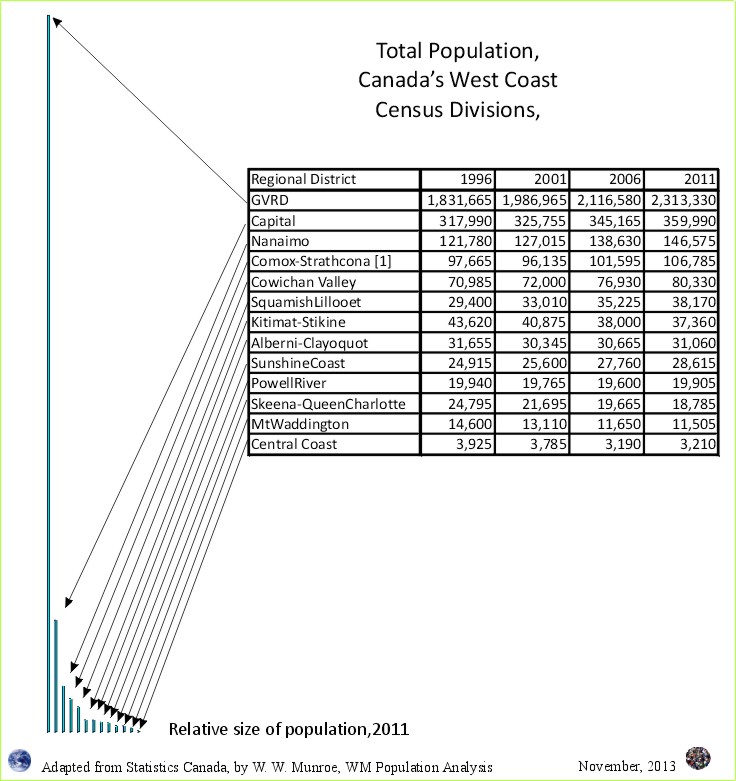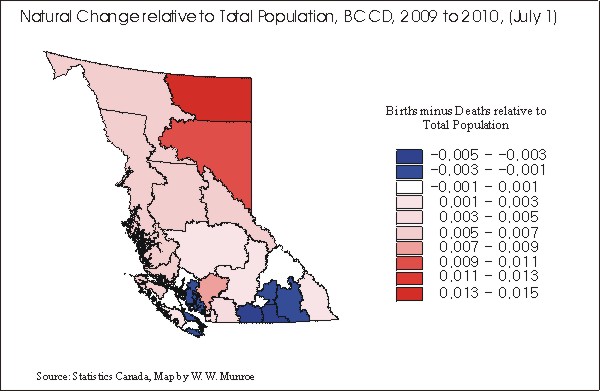Comparison of the number of people residing in Canada's West Coast Census Divisions (Regional Districts).
Like other river deltas reaching oceans, the Greater Vancouver Regional District (GVRD) has a relatively large population and high density of people compared to other regions on Canada's west coast.

While the GVRD is home to 70% of the coastal regions population, this region, containing municipalities surrounding the largest port in Canada, gained a disproportionately large population increase, over 85% between 2006 and 2011.
Therefore, all the other regions received less, except for the Squamish-Lillooet Regional District which received very marginally more relative to it's portion of the total population of coastal Regional Districts.
The transportation improvements needed to integrate the GVRD with it's northern neighbour Squamish-Lillooet Regional District, allowed an alternative to eastern expansion further inland and up the river valley. The 2010 Winter Olympics held in both the GVRD and the Squamish-Lillooet Regional District provided justification and money to upgrade and widen the roads.
Between 1996 and 2011, the Squamish-Lillooet Regional District had the highest population growth rate of all coastal regions at 30% (from 29,400 to 38,140) followed by the GVRD at 26% (1,831,665 to 2,313,330).

The GVRD's relatively high population increase is due to a combination of high natural change and in-migration. The GVRD has by far the highest natural change (births minus deaths) on the west coast. As well, as the high number of international in-migrants, intra provincial in-migration to the GVRD (migration from other regions within BC) increases during the bust side of the boom-bust economic/migration cycle.
On the other side of the Salish Sea (formerly the Georgia Straight), the Capital Region is home to just over 11% of the coastal region's population, yet received only 6% of the increase in population between 2006 and 2011. More deaths than births in the Capital Region is slowing population growth there..
Together, the GVRD and the Capital Region are home to ~85% of the west coast region district's population with 2.67 million people counted in 2011.
While the south coast regions have seen a continued increase in population since 1996, the northern regions have experienced a decline. When combined, the Kitimat-Stikine, Skeena-Queen Charlotte, Mt. Waddington, and Central Coast region's portion of the total population for the coastal regions, has decreased from 3.3% to 2.2%, and the total population for these areas has declined from ~87,000 to ~71, 000.
The decline in population for the northern regions indicates a fundamental shift from expansion to contraction.
Adapted from Statistics Canada, 2011 Census of Population, by W. W. Munroe, WM Population Analysis.
Statistics Canada. 2012. Population and dwelling counts, for Canada, provinces and territories, 2011 and 2006 censuses (table). Population and Dwelling Count Highlight Tables. 2011 Census.
Statistics Canada Catalogue no. 98-310-XWE2011002. Released February 8, 2012.
